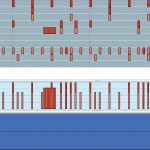MIDI – Can you write better music by stripping down to the bare essentials?
Recently I was asked to contribute a few tracks to a puzzle game for the Game Maker community. Not a problem I thought as I perused the brief – a track 45 seconds in length that loops….pretty normal stuff, however lurking lower down the page were words I had never seen before – Format: GM – MIDI
This…this could be a problem
Being a desktop based producer I am fairly au-fait with MIDI. I use it to sequence music, control software parameters and to control hardware, but, the one thing I had yet to do was deliver a completed track in a MIDI format. To make matters worse the audio engine being used for the game could not use sound-fonts and therefore had to use the general MIDI sound-set.
It is a very strange feeling, to have amazing technology, an array of instruments and effects plus a barrage of samples at your disposal and not use them, however, much to my surprise it was extremely liberating.
By getting rid of superfluous features I was able to get right down to the music focusing purely on rhythm and melody and to a certain extent forget about utilising fancy production techniques or creating a tonal landscape, the focus being on creating a catchy “tune”.
A few days later I had the pleasure of watching a talk by Tommy Tallarico. During this talk Tommy discussed the proliferation of “hollywood” scores in games and how game developers are often so obssessed with sounding like the latest blockbuster film that they forget about the “hook” oriented music of yesteryear. This was music mastered by composers such as (my personal favourite) Koji Kondo and Tommy Tallarico himself who were both able to create large, immersive worlds of sound that were dynamic and unforgettable. Take a look at The Legend of Zelda and Earthworm Jim if you don’t believe me.
After seeing the Tallarico talk I went back to my original MIDI composition and put it into my DAW, replete with a cornucopia of effects and fancy samples to create a more “typical”, “modern” sound. The result? An big orchestral sound with a catchy them. However, there was more to it than that. Due to it’s simplicity the music I had written now seemed so much more versatile. It felt to me like a collection of amorphous notes, agnostic of restrictions like genre and tempo.
So. The next time you head to your keyboard and 400 trillion gigabyte sample library consider instead ditching the fancy baubles in favour of General MIDI. You might be pleasantly surprised by your results.
If you try this, let me know by leaving a comment below, I’d like to hear your experiences with the stripped down approach.


Ryan,Great idea.